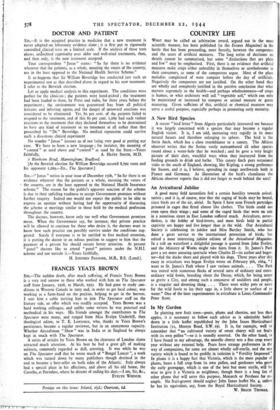An Avicultural Jubilee A g ood many field naturalists feel a
certain hostility towards avicul- turists ; and it is, of course, true that the caging of birds may be brutal, since birds are of the air, aerial. In Spain I have seen French partridges prisoned in cages that fitted almost like clothes. The birds could not even open their wings ; and some of the caged birds that were on sale in a notorious street in East London suffered much. Aviculture, never- theless, is the hobby of bird-lovers, and most birds held in partial captivity are happy and live longer than in the wild. Our Avicultural Society is celebrating its jubilee and Miss Barclay Smith, who has done a great service to the international protection of birds, has edited a most interesting jubilee edition of the Avicultural Magazine. In a talk on waterfowl a delightful passage is quoted from John Evelyn, and the Ministry of Works might take hints from it. SL James's Park gave a yet more amusing spectacle when Charles II—its author and beget- ter—fed the ducks there and played with his dogs. Three years after this essay in aviculture was begun Evelyn wrote on February 9th, 1664, " I went to St. James's Park where I saw various animals. . . . The Park was stored with numerous flocks of several sorts of ordinary and extra- ordinary wild fowle, breeding about the Decoy, which, for being neere so grette a City, and among such a concourse of souldiers and people, is a singular and diverting thing. . . . There were withy pots or nests for the wild fowle to lay their eggs in, a little above ye surface of ye water." One of the later experimenters in aviculture is Lieut.-Commander Peter Scott.


























 Previous page
Previous page